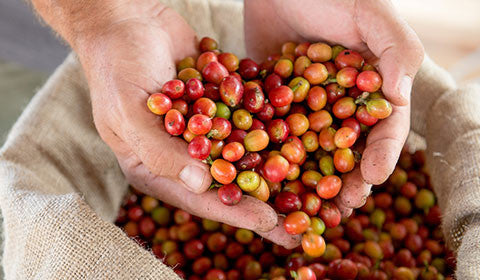Why Kona

It’s no small coincidence that one of the most sought-after coffees in the world comes from Kona. The Kona District on Hawaii’s Western Coast has a uniquely consistent climate that allows for the production of some of the richest, most flavorful coffee beans in the world. Coffee plants need a precise combination of sunshine, shade and rainfall for optimal growth – conditions present in only a small handful of locations around the world. Kona offers it all: a balanced dose of bright sunshine in the morning, followed by moist humidity and rainfall in the afternoon and mild evenings. Mineral-rich, porous volcanic soil allows Kona coffee cherries to blossom into vibrant coffee plants.
Kona coffee is terroir at its best.
Hand-harvested from small producers
Tradition and family is incredibly important in Kona. Many of the approximately 600 local farms in the region are family-owned with an average farm size of 5 acres, creating a strong and cohesive sense of community among the farmers. These families are passionate about creating the purest and most delicious coffee possible, just like the generations before them. Each step of the coffee-making process is done by hand, from the picking to the sun drying and roasting. This process is a labor of love and tradition for the Kona people. Carta Coffee mirrors that same Kona tradition as family-run coffee farm that produces small-batch, hand-harvested coffee.


Richness in a cup
The Kona coffee tasting experience is extremely complex, more like that of wine than the average coffee. Smell Kona Coffee before you drink, and you may notice fruity, nutty, caramel, chocolate or floral aromas, depending on the roast. As you take your first sip, you will taste a citrusy sweetness - from mellow to piquant - with a smooth, buttery finish. The coffee’s body is full and creamy, with bright and well-balanced acidity. A delicious experience.
From then to now – the Kona coffee journey
The estate-grown coffee history in Kona began in 1828, when Samuel Reverend Ruggles brought coffee plants to the region from Brazilian cuttings. During that same century, Henry Nicholas Greenwall, an English merchant, developed Kona into a recognized coffee-making region. Large plantations were common in the area until the world coffee market crash in 1899. From then on, owners leased their land to their workers, who were commonly Japanese and Filipino. These families still work on those farms today, producing the 100% Kona Coffee known around the world for its richness and quality.
Although fueled by generations of experience and tradition, Kona farmers still face several issues. In 2010, the Coffee Berry Borer beetle, which eats coffee beans from inside the cherry, was identified in Kona. The beetle can destroy up to 90% of a coffee crop if it is not taken care of and has greatly impacted the Kona coffee industry. As well, farmers producing 100% Kona coffee compete with Kona coffee blends, which require that only 10% of coffee comes from Kona. Most of these blends contain little of the terroir-rich flavors of true Kona coffee and are offered at a much lower price point.

